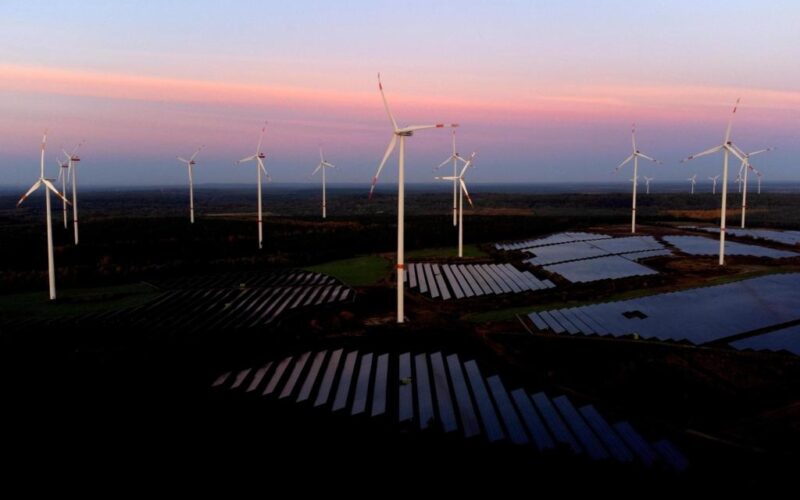By ALEXA ST. JOHN
Worldwide solar and wind power generation has outpaced electricity demand this year, and for the first time on record, renewable energies combined generated more power than coal, according to a new analysis.
Global solar generation grew by a record 31% in the first half of the year, while wind generation grew by 7.7%, according to the report by the energy think tank Ember, which was released after midnight Tuesday London time. Solar and wind generation combined grew by more than 400 terawatt hours, which was more than overall global demand increased in the same period, it found.
The findings suggest it is possible for the world to wean off polluting sources of power — even as demand for electricity skyrockets — with continued investment in renewables including solar, wind, hydropower, bioenergy and geothermal energies.
“That means that they can keep up the pace with growing appetite for electricity worldwide,” said Małgorzata Wiatros-Motyka, senior electricity analyst at Ember and lead author of the study.
At the same time, total fossil fuel generation dropped slightly, by less than 1%.
“The fall overall of fossil may be small, but it is significant,” said Wiatros-Motyka. “This is a turning point when we see emissions plateauing.”
The firm analyzes monthly data from 88 countries representing the vast majority of electricity demand around the world. Reasons that demand is increasing include economic growth, electric vehicles and data centers, rising populations in developing countries and the need for more cooling as temperatures rise.
Meeting that demand by burning fossil fuels such as coal and gas for electricity releases planet-warming gases including carbon dioxide and methane. This leads to more severe, costly and deadly extreme weather.
Analyzing major markets
Ember also dedicated part of its report to an analysis of China, India, the European Union and the U.S. Combined, they account for nearly two-thirds of electricity generation and carbon dioxide emissions from the power sector globally.
In the first six months of the year, China added more solar and wind than the rest of the world combined, and its fossil fuel generation fell by 2%, the report said.
India saw record solar and wind growth that outpaced the growth in demand. India’s fossil fuel generation also dropped.
In both nations, emissions fell.
“It’s often been said by analysts that renewable energy doesn’t really lead to a reduction in fossil fuel use,” said Michael Gerrard, founder and director of the Columbia University Sabin Center for Climate Change Law, who was not involved in the report. “This report highlights an encouraging step in the opposite direction.”

But in the U.S., demand growth outpaced the growth of clean power generation. In the E.U., sluggish wind and hydropower generation contributed to higher coal and gas generation, the report said. In both markets, fossil fuel generation and emissions increased.
Challenges in the US
The U.S. clean energy market faces challenges as President Donald Trump’s administration shifts federal policy away from renewables and toward boosting coal, oil and gas production. The administration has terminated Biden-era funding that supported clean energy projects, repealed policy underpinning climate-related regulation and halted wind energy developments.
Meanwhile, the administration has lifted barriers to coal mining, granted two years of regulatory relief to coal-fired power plants and other polluting industries and dedicated millions of dollars to these coal plants.
In his speech at the United Nations General Assembly last month, Trump attacked renewable energy and questioned the validity of the concept of climate change.

Experts warn that Trump’s efforts to block clean energy will have a long-term impact.
“The federal government is greatly increasing the growth of artificial intelligence, which is going to massively increase electricity demand, and they’re also shutting down the cheapest new sources of electricity, wind and solar. That’s going to lead to a gap in supply and demand,” Gerrard said.
Renewables “still have an opportunity to make inroads in to displacing fossil fuels, even with some demand growth,” said Amanda Smith, senior scientist at research organization Project Drawdown, who also wasn’t involved in the report. But, Smith said: “I am very cautiously optimistic that renewables can continue to grow and continue to displace fossil fuels in the U.S. I am more optimistic on the world scale.”
Alexa St. John is an Associated Press climate reporter. Follow her on X: @alexa_stjohn. Reach her at ast.john@ap.org.
Read more of AP’s climate coverage.
The Associated Press’ climate and environmental coverage receives financial support from multiple private foundations. AP is solely responsible for all content. Find AP’s standards for working with philanthropies, a list of supporters and funded coverage areas at AP.org.
Originally Published:








